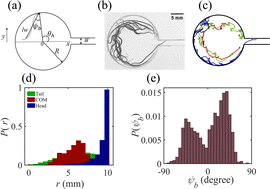Escape dynamics of confined undulating worms†
Abstract
We investigate the escape dynamics of oligochaeta Lumbriculus variegatus by confining them to a quasi-2D circular chamber with a narrow exit passage. The worms move by performing undulatory and peristaltic strokes and use their head to actively probe their surroundings. We show that the worms follow the chamber boundary with occasional reversals in direction and with velocities determined by the orientation angle of the body with respect to the boundary. The average time needed to reach the passage decreases with its width before approaching a constant, consistent with a boundary-following search strategy. We model the search dynamics as a persistent random walk along the boundary and demonstrate that the head increasingly skips over the passage entrance for smaller passage widths due to body undulations. The simulations capture the observed exponential time-distributions taken to reach the exit and their mean as a function of width when starting from random locations. Even after the head penetrates the passage entrance, we find that the worm does not always escape because the head withdraws rhythmically back into the chamber over distances set by the dual stroke amplitudes. Our study highlights the importance of boundary following and body strokes in determining how active matter escapes from enclosed spaces.



 Please wait while we load your content...
Please wait while we load your content...
